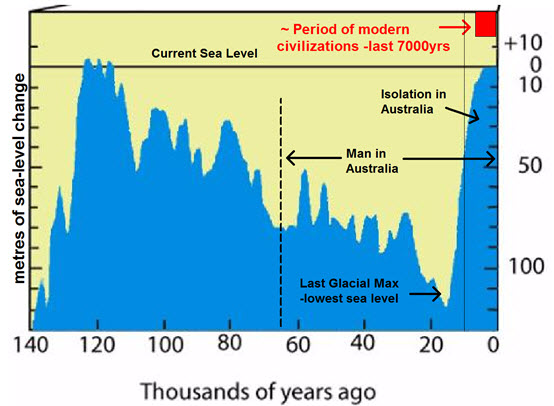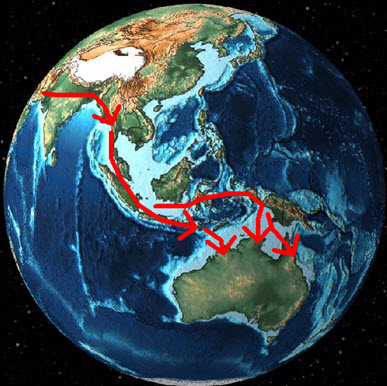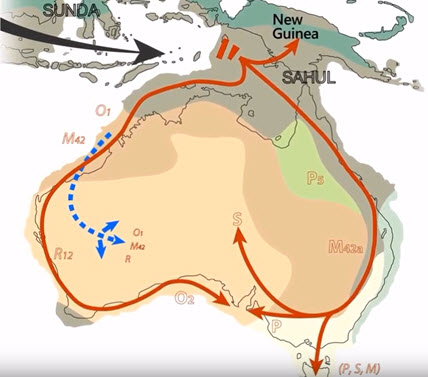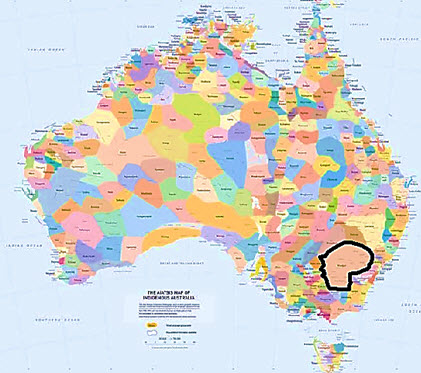14. Modern Man enters Australia – about 65,000 yrs ago
Background: From origins in Africa, archaeological studies show multiple radiations/migrations of primitive man to places around the world. In Indonesia there is evidence of Homo erectus living in Java at least 700,000 years ago. Even with the very low sea levels during the Pleistocene ice-age period, access into Australia seems likely to have been blocked by spans of a few tens of kilometres of sea.
Modern Man (Homo sapiens): The earliest habitation sites known within Australia have a maximum date of about 65,000 yrs, and multiple habitation sites across Australia have dates between 30,000 & 50,000 years. Modern Man with the assistance of simple boats seems likely to have entered NW Australia more than 50,000 years ago when the sea level was about 70 metres below present level. The sea level remained low and dropped to about 120 metres below current level during the last glacial maximum between 20,000 & 18,000 years ago. Until about 18,000 years ago, travel in & out of Australia would have been relatively easy. Subsequent global warming raised the sea level to current levels by about 8000 years ago. This effectively isolated Australia until boats were used that could handle substantial sea crossings.

Chart of Sea-level change over the last 140,000 years

Land Bridge SE Asia to Australia

Probable migration routes of the 1st human settlers in Australia – starting about 50,000 years ago

AIATSIS Map of Indigenous Australia (Wiradjuri land outlined)

Logarithmic time scale – providing world time context/relationships. The red box represents this part of story.
Aboriginal Culture: In the last 10,000 years, during which a multitude of civilizations developed across the globe, led by pottery using cultures in SE Asia & Europe, and linen textile producing cultures in Mesopotamia, Aboriginal people in Australia were isolated to further develop their own unique culture. Eur-Asian cultural development seems characterized and catalyzed by clashes & battles between neighboring cultures. In contrast isolated Australian culture dealt only with the natural environment. As in Europe, a culture involving artworks on rock walls was well established 10,000 years ago and continued.
Unlike Eur-Asian cultures, the Australian Aboriginal culture did not develop built structures, machines & hard documentation systems. There was strong emphasis on respect for the land, the animals & plants. A spiritual connectivity with these natural things was established. A culture developed in which each individual was assigned a totem (eg Emu) for which the individual and totem had a special relationship and duty of care. The culture embodied a system of sacred ceremonies & initiations. There was a system of justice, and a system of protocols for relationships & negotiation. They manufactured and used stone, timber and fiber tools – utility items. Provision of food, a primary necessity for all cultures seems in the case of Australian Aboriginals to have been largely aided by the use of fire with the burning of tracts of natural vegetation. It has been argued that this burning was done in a very selective & skillful manner to maximize the long term predictable grazing of kangaroos – a primary source of food. Story telling was and still is a key method of transmitting knowledge & tradition to successive generations. Many places hold special meaning and are considered sacred, and were marked with carved timber or stone arrangements.
Across Australia, over 200 Aboriginal groups (nations) became defined. Many groups/nations spoke with unique languages or dialects.
Wiradjuri Nation: The Wattle Flat/Bathurst area lies within the largest Aboriginal nation group in NSW, the Wiradjuri Nation, within which Wiradjuri language was spoken. The Wattle Flat area lies near the north-eastern boundary of the Wiradjuri lands. Wiradjuri land is closely linked to 3 defining river systems: the Wambool (Macquarie River); the Kalare (Lachlan River); and the Murrumbidgee. Towns within Wiradjuri lands include: Bathurst; Orange; Dubbo; Mudgee, Wagga Wagga, Condobolin & West Wyalong.
Climate Change: One extended challenging period for many Aboriginal communities would have been between 18,000 & 8,000 years ago during which the sea level rose 130 metres and the climate became considerably warmer. Aboriginal community sites close to the coastline would have become successively inundated forcing communities to move.
New settlers: By far the most challenging period for Australian Aboriginal communities began just 230 years ago in 1788 when British colonial settlers started arriving after Captain Cook claimed Australia for the British Crown. There was very little in common between Aboriginal culture & British colonial culture. Respect & understanding by the incoming settlers for the long incumbent residents was very limited. Australia quickly became a resource to be exploited. Some grassland areas probably long maintained by Aborigines using selective burning were often referred to as “park” like land by colonialists. These were perfect for sheep grazing. The Bathurst river flats & perhaps a grassy hilltop flat, (Wattle Flat) were among these and were selected for cropping & sheep runs respectively.